Smeagull the Seagull: A True Story
Air Date: Week of December 20, 2019
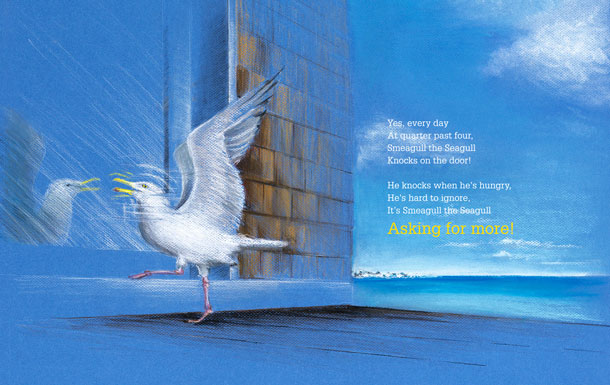
Smeagull the Seagull comes to the house near the shore every day and knocks on the sliding glass door. (Illustration by Valerie Elaine Pettis) Buy a signed copy of Smeagull the Seagull and support Living on Earth
Smeagull the Seagull comes to the house near the shore every day and knocks on the sliding glass door. He knocks when he’s hungry and the people who live there feed him. Those humans are Living on Earth’s Explorer-in-Residence Mark Seth Lender, and his wife and illustrator Valerie Elaine Pettis. Their new children’s book Smeagull the Seagull: A True Story teaches young children about the value of experiencing and protecting animals and nature. Mark reads his book aloud, followed by a conversation with Host Steve Curwood about the unusual creatures he's befriended, which include stinging insects as well as Smeagull.
Transcript
[THEME]
CURWOOD: From PRX and the Jennifer and Ted Stanley Studios at the University of Massachusetts Boston, this is Living on Earth, I’m Steve Curwood.
In this season of the winter solstice in the Northern Hemisphere we are taking a break from the rush of news to share some stories to welcome in the lengthening days. Our theme today is the animals around us, both real and from the hearts of our imagination. We begin with a story by Living on Earth’s Mark Seth Lender about a herring gull that visits his Connecticut home every day, looking to be fed, of course. Here is Mark reading his book, Smeagull the Seagull.
[MUSIC: Smeagull’s Theme. This is a piano composition written by Steinway Artist, Stacey Rose]
LENDER: There's a house near a seawall, facing the shore, and that house has a porch with a sliding glass door. And the people who live there, Valerie and me, stand by that door and look toward the sea.
Because Smeagull the Seagull knows that we know. He comes in the rain. He comes in the snow.
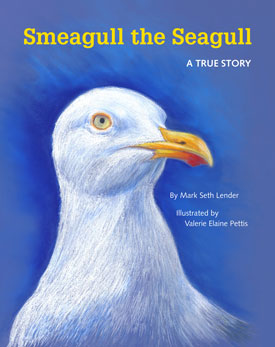
Smeagull The Seagull is available now. (Illustration by Valerie Elaine Pettis)
He comes in summer, I'm telling the truth. He comes when icicles hang from the roof.
He comes in the spring. He comes in the fall. He comes when it's cloudy, and there's no sun at all.
Yes, every day at quarter past four, Smeagull the Seagull knocks on the door. He knocks when he's hungry. He's hard to ignore. It's Smeagull the Seagull, asking for more.
Again in the morning at 10 past 6, Smeagull comes knocking. It's loud as a stick when he knocks with his beak on the sliding glass door. It's Smeagull the Seagull, asking for more.
Wherever you live Seagull is heard. It’s spoken by Smeagull and millions of birds.
I can say I'm tired and I'm going to bed.
I can say I'm hungry and I want to be fed.
I can say I'm angry, angry and mad.
I can say please. I can say I'm so sad.
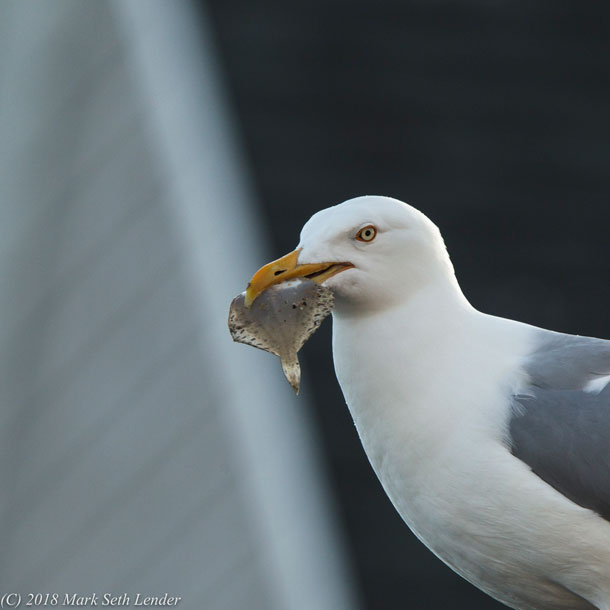
The book is based on the story of the real “Smeagull” who would often greet Mark and Valerie at their Connecticut home. (Photo: Mark Seth Lender)
Some people think they're smarter than birds. But can they speak Seagull? Not one single word.
I was talking and talking. I was all out of breath. So I started knocking, knocking works best. My people know when I knock on the door, it's Smeagull the Seagull, and I'm here for more.
I only eat fish from the Starfish Store. I'm a star, named Smeagull, and I'm ready for more.
Smeagull the Seagull walks down the beach. He lands on the seawall, he flies out of reach. All of the children, all over the town cry, there goes Smeagull! Smeagull’s around!
All that walking and flying keeps Smeagull fit, but it does make him hungry, and he eats quite a bit. So we bought a new freezer, with a really big shelf. Full of fish, for Smeagull, it's all for himself!
It stands in the kitchen from ceiling to floor. We thought we'd be ready when Smeagull said, “more.”
Then Valerie cried “Where’s Smeagull’s fish! The shelf is empty. There's no food in his dish! Starfish will be closing in a minute or two.”
I said, “Start the pickup!” Down the driveway we flew.
Captain Mike had the keys. He was locking the store. He was fresh out of fish. But he said, “I’ll get more.”
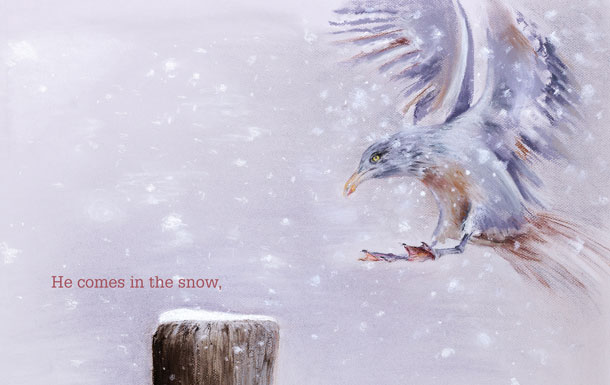
Hungry for scraps of sustainable seafood, Smeagull visits even in a snowstorm. (Illustration by Valerie Elaine Pettis)
So he climbed aboard his boat, the Collette, named after his wife who keeps Starfish as pets.
“Don't worry,” he said, “we're not finished yet, I'll head out to sea, and see what I get.”
The engine roared. He was soon out of sight. “If we have to,” we called, “We'll wait here all night.”
Captain Mike returned with a net full of smelts. “They're fish” he said, “they’re good for your health.”
And he gave us enough to fill Smeagull’s shelf.
We drove home in the pickup with our fish neatly wrapped. Smeagull didn't greet us, was he taking a nap?
All we could do was shake our heads.
“We have to find Smeagull,” was all that we said.
All of the children all over the town helped look for Smeagull. They looked up, they looked down.
They looked in the trees. They looked on the ground. But Smeagull The Seagull was not to be found.
We were tired and hungry, but we couldn't eat. We turned off the lights, but we couldn't sleep.
It was cold, and windy, and day after day, we waited for Smeagull but he'd gone away.
The sea cannot hear you. The sky cannot speak. Life without Smeagull is lonely and bleak.
But what is that sound I hear at the door? That knock, it’s familiar! We ran cross the floor.
“I'm Smeagull The Seagull. I'm back with my seagull. Her name is Shegull. She's a seagull like me. There's an egg in our nest and we’ll soon be a family of three.”
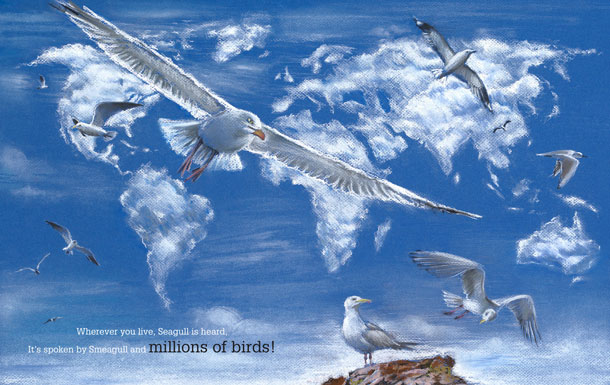
The calls of the gulls are a familiar sound not only at the coast, but far inland. Seagulls are found on every continent including Antarctica. (Illustration by Valerie Elaine Pettis)
There used to be one gull and now there are three gulls. Smeagull, Shegull, and baby gull Megull.
They're our family birds and we love them too much for words.
[MUSIC: Smeagull’s Theme. This is a piano composition written by Steinway Artist, Stacey Rose]
CURWOOD: That's Living on Earth's Explorer-In-Residence, Mark Seth Lender and his story about Smeagull the Seagull. And he joins me now. Hi there, Mark.
LENDER: Hi, Steve.
CURWOOD: So, how did you become friends with Smeagull to begin with?
LENDER: It was kind of his idea. We had begun feeding the migratory ducks about this time of year. And I noticed one particular seagull coming down the seawall, where the ducks were being fed, eating only the corn and only the whole kernels of corn. The next time I saw him, he was eating the sunflower seeds only out of the bird seed, but only the sunflower seeds still within their shells. And I said, oh, this is my kind of bird.
CURWOOD: A picky eater, you mean?
LENDER: Neurotic!
CURWOOD: Neurotic? All right, tell me more.
LENDER: He gave other indications of his intelligence and I thought, you know, he just made himself stand out, I guess is what I'm really saying. He figured out right away that he had my interest. And then I began to feed him fish scraps and the deal was done. He learned when we woke up, and by degrees, he just got our number. And then, oh, I don't know a number of months into the relationship, he would come to the sliding glass door to our little porch. And I would see him, I would hear him, go get him some food. And I would see him studying the glass, and on his own, without being shown anything by us, he figured out eventually that glass had transparency and solidity. And he began to knock. And when he knocks, it's not like a bird pecking at the window. This is the way a human would knock if they really wanted your attention and they were in a hurry. And Smeagull's always in a hurry. So that became the routine.
CURWOOD: Tell me this Mark, at what point did this seagull somehow managed to insert a ring through your nose?
LENDER: He's a very intelligent seagull. And I am prone to nose rings, when it comes to wild animals. You know, I pay a lot of attention to them. I see wild animals as "us", by which I mean closer together with our species, than different from it. A great deal of effort in the history of Western civilization has gone to separating us from the rest of life on earth. And I think that is a gross error. From an evolutionary standpoint, animals like us, which is to say animals with eyes and faces are a very small cohort. They tend to recognize each other. I mean, I have had dealings with paper wasps that clearly know where my eyes are, where my head is, that my thought processes are going on inside that head, and that if they want my attention, that's the place to come to.
CURWOOD: So Mark, you're telling me that you are connected with stinging insects?
LENDER: There's a story I have that I can share with you. Would you like to hear it?
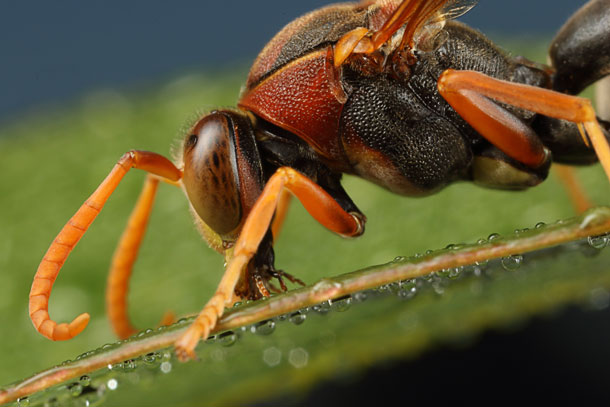
A paper wasp, drinking the dew from a leaf. (Photo: Patrickkavanagh, Flickr, CC BY 2.0)
CURWOOD: Okay.
LENDER: One of those nights.
I woke at two in the morning.
The mind begins working.
I am a friend of the dark. Not that. But what I know goes on in the day. The fate of Nature. The creatures in it. Valerie without whom...
Unable to keep my head up, mid-afternoon, the sun shining I lay down, soon deep and dreaming.
Until the buzzing started.
BZZZZ-zut ZUZ B'ZIZ!
Too throaty and strong and loud to be a fly. Something formidable.
BZZZ-UZ-UZ ZUZ!
I open my eyes:
Paper wasp.
Around my head –
BZZZ-UZ-UZ ZUZ!
-- and to the window.
And around my head --
-- and to the window.
The right window.
Not the solid five-foot pane of insulating glass but the small one alongside, the casement, the one that opens.
I get up, walk over.
Paper wasp is resting on the frame, not at the hinge but at the leading edge. Her wings not beating. Waiting.
Turn the crank --
Window pivots out --
Paper Wasp, escapes.
And everything I thought I knew about Life on Earth is upended.
CURWOOD: Okay, so you've obviously made friends with the paper wasp. Mark, I understand that you've also connected with yellow jackets?
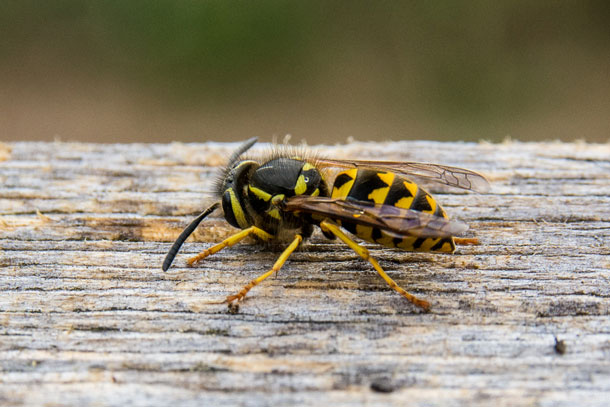
Mark has even befriended the yellow jackets in his home. (Photo: Tyler Ingram, Flickr, CC BY-NC-ND 2.0)
LENDER: Well, after the incident I just told you about I said, well, you know if I can relate to this, then I can probably relate to the rest of them and I began to shoo the yellow jackets who use our houses a thoroughfare at certain times of year. I began to shoo them out. And then I found one morning, two of them just sitting in the bay window, who had not escaped and had dehydrated overnight. And you know, they have a very high metabolism. So they have to eat fairly frequently and they dehydrate, which is their other problem. I ran into the kitchen, got some unfiltered honey and a little bit of water and fed her off my fingers. And she right away knew what I was doing. And her little antennae started working. And she revived and so did the one next to her. I fed that one also. Opened the window, gave them a little clearance, and when I came back about 10 minutes later they had escaped.
CURWOOD: Mark, what kind of a relationship can you really have with insects?
LENDER: Well, enough of one that Paper Wasp figured out that this large hive is occupied by a living creature, who I can show him I want to get out of here and he'll let me. I would say that's quite a bit of relationship. I mean, it doesn't cut the other way. I can't ask them for anything. But they have the capacity to ask me. And that's true of Smeagull the Seagull as well.
CURWOOD: Thanks, Mark. Mark Seth Lender is Living on Earth's Explorer-in-Residence.
LENDER: Thank you, Steve. It's been a pleasure.
Links
Buy a signed copy of Smeagull the Seagull and support Living on Earth
Living on Earth wants to hear from you!
Living on Earth
62 Calef Highway, Suite 212
Lee, NH 03861
Telephone: 617-287-4121
E-mail: comments@loe.org
Newsletter [Click here]
Donate to Living on Earth!
Living on Earth is an independent media program and relies entirely on contributions from listeners and institutions supporting public service. Please donate now to preserve an independent environmental voice.
NewsletterLiving on Earth offers a weekly delivery of the show's rundown to your mailbox. Sign up for our newsletter today!
 Sailors For The Sea: Be the change you want to sea.
Sailors For The Sea: Be the change you want to sea.
 The Grantham Foundation for the Protection of the Environment: Committed to protecting and improving the health of the global environment.
The Grantham Foundation for the Protection of the Environment: Committed to protecting and improving the health of the global environment.
 Contribute to Living on Earth and receive, as our gift to you, an archival print of one of Mark Seth Lender's extraordinary wildlife photographs. Follow the link to see Mark's current collection of photographs.
Contribute to Living on Earth and receive, as our gift to you, an archival print of one of Mark Seth Lender's extraordinary wildlife photographs. Follow the link to see Mark's current collection of photographs.
 Buy a signed copy of Mark Seth Lender's book Smeagull the Seagull & support Living on Earth
Buy a signed copy of Mark Seth Lender's book Smeagull the Seagull & support Living on Earth

